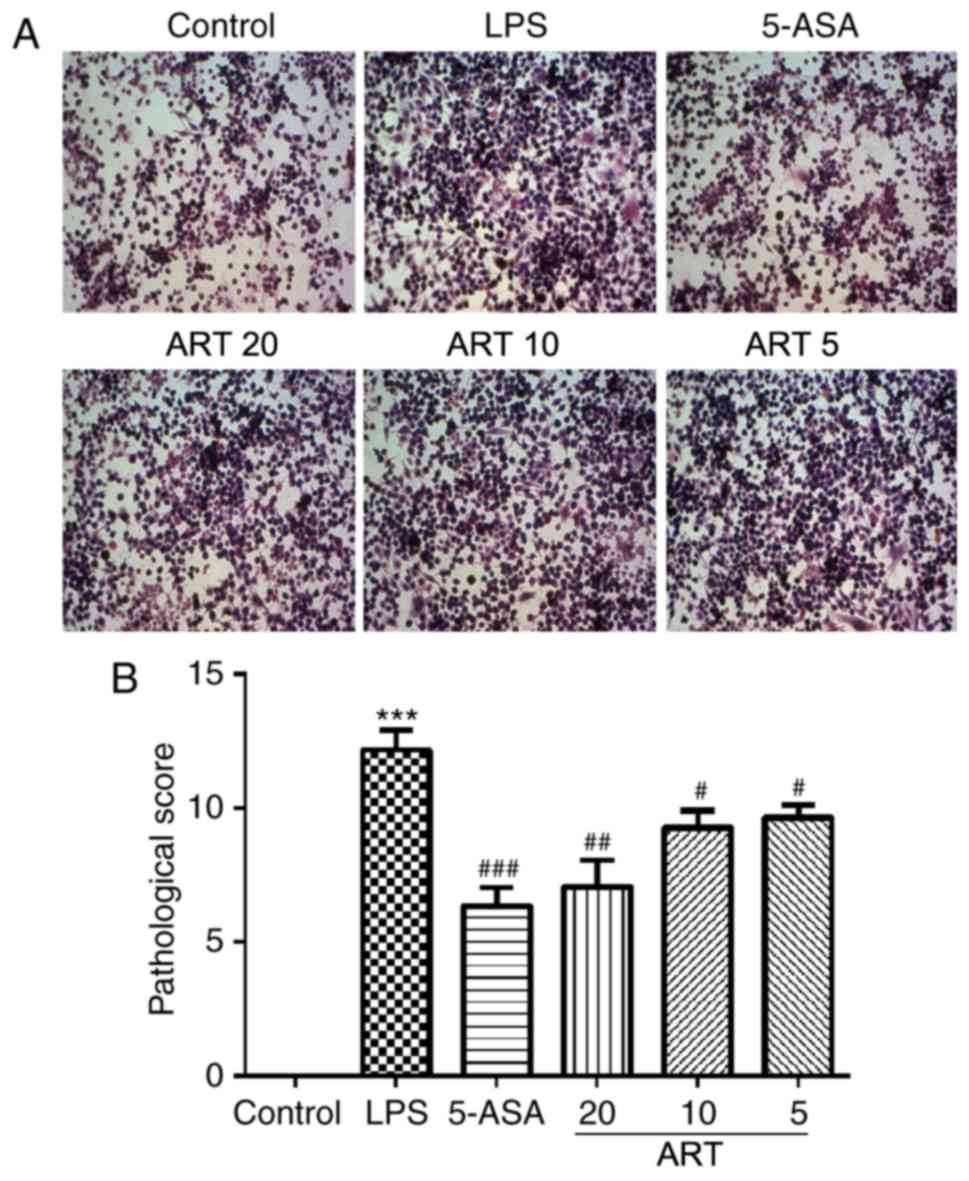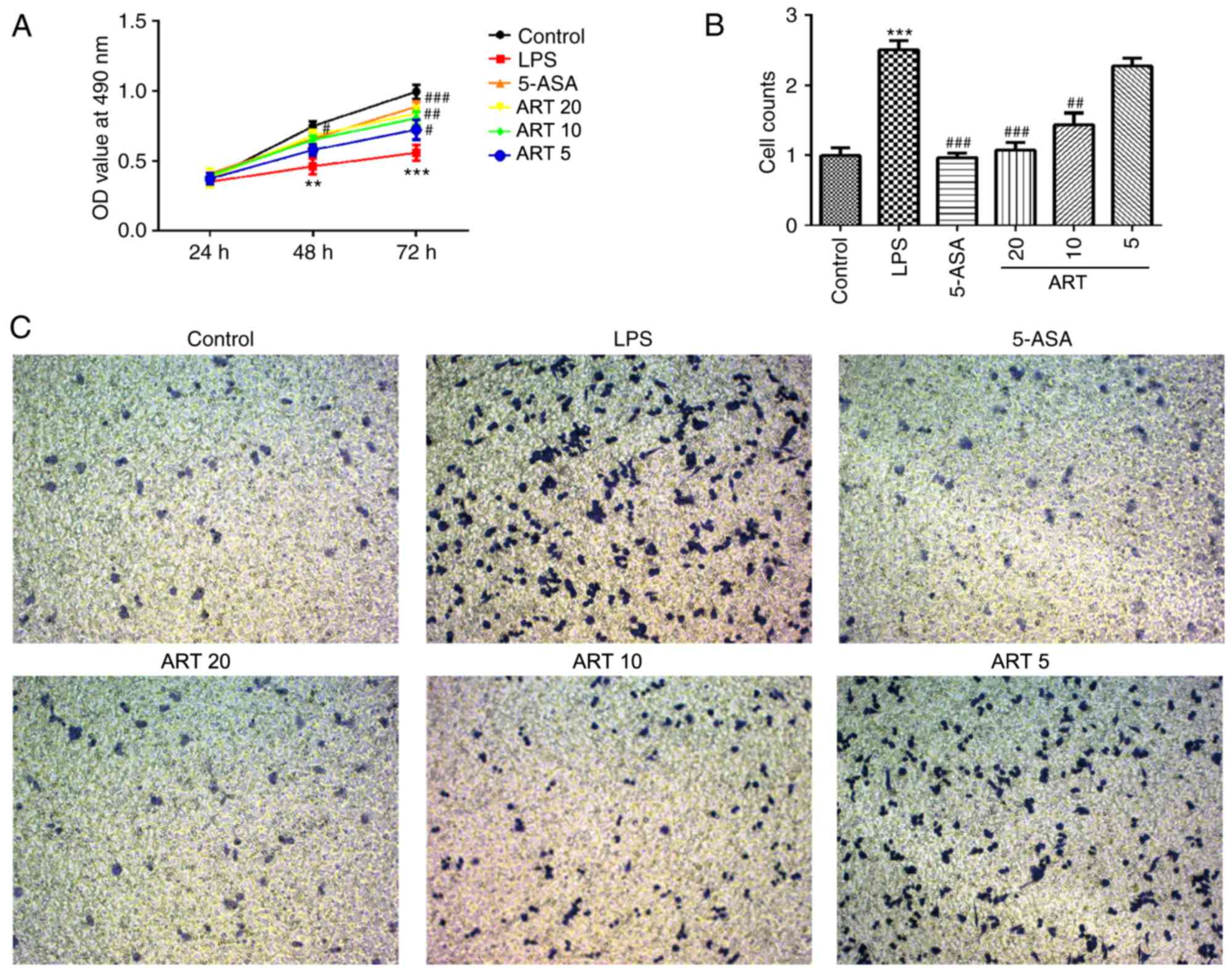|
1
|
Ito A, Omori T, Hanafusa N, Tsuchiya K,
Nakamura S and Tokushige K: Efficacy and safety of granulocyte
adsorption apheresis in elderly patients with ulcerative colitis. J
Clin Apher. 33:514–520. 2018. View Article : Google Scholar : PubMed/NCBI
|
|
2
|
Høivik ML, Moum B, Solberg IC, Henriksen
M, Cvancarova M and Bernklev T; IBSEN Group, : Work disability in
inflammatory bowel disease patients 10 years after disease onset:
Results from the IBSEN Study. Gut. 62:368–375. 2013. View Article : Google Scholar : PubMed/NCBI
|
|
3
|
Torres J, Billioud V, Sachar DB,
Peyrin-Biroulet L and Colombel JF: Ulcerative colitis as a
progressive disease: The forgotten evidence. Inflamm Bowel Dis.
18:1356–1363. 2012. View Article : Google Scholar : PubMed/NCBI
|
|
4
|
Ungaro R, Mehandru S, Allen PB,
Peyrin-Biroulet L and Colombel JF: Ulcerative colitis. Lancet.
389:1756–1770. 2017. View Article : Google Scholar : PubMed/NCBI
|
|
5
|
Tsuda K, Miyamoto L, Hamano S, Morimoto Y,
Kangawa Y, Fukue C, Kagawa Y, Horinouchi Y, Xu W, Ikeda Y, et al:
Mechanisms of the pH- and oxygen-dependent oxidation activities of
artesunate. Biol Pharm Bull. 41:555–563. 2018. View Article : Google Scholar : PubMed/NCBI
|
|
6
|
Efferth T, Giaisi M, Merling A, Krammer PH
and Li-Weber M: Artesunate induces ROS-mediated apoptosis in
doxorubicin-resistant T leukemia cells. PLoS One. 2:e6932007.
View Article : Google Scholar : PubMed/NCBI
|
|
7
|
Ooko E, Saeed ME, Kadioglu O, Sarvi S,
Colak M, Elmasaoudi K, Janah R, Greten HJ and Efferth T:
Artemisinin derivatives induce iron-dependent cell death
(ferroptosis) in tumor cells. Phytomedicine. 22:1045–1054. 2015.
View Article : Google Scholar : PubMed/NCBI
|
|
8
|
Button RW, Lin F, Ercolano E, Vincent JH,
Hu B, Hanemann CO and Luo S: Artesunate induces necrotic cell death
in schwannoma cells. Cell Death Dis. 5:e14662014. View Article : Google Scholar : PubMed/NCBI
|
|
9
|
Berdelle N, Nikolova T, Quiros S, Efferth
T and Kaina B: Artesunate induces oxidative DNA damage, sustained
DNA double-strand breaks, and the ATM/ATR damage response in cancer
cells. Mol Cancer Ther. 10:2224–2233. 2011. View Article : Google Scholar : PubMed/NCBI
|
|
10
|
Eling N, Reuter L, Hazin J, Hamacher-Brady
A and Brady NR: Identification of artesunate as a specific
activator of ferroptosis in pancreatic cancer cells. Oncoscience.
2:517–532. 2015. View Article : Google Scholar : PubMed/NCBI
|
|
11
|
Cen Y, Liu C, Li X, Yan Z, Kuang M, Su Y,
Pan X, Qin R, Liu X, Zheng J and Zhou H: Artesunate ameliorates
severe acute pancreatitis (SAP) in rats by inhibiting expression of
pro-inflammatory cytokines and Toll-like receptor 4. Int
Immunopharmacol. 38:252–260. 2016. View Article : Google Scholar : PubMed/NCBI
|
|
12
|
Sands BE and Kaplan GG: The role of
TNFalpha in ulcerative colitis. J Clin Pharmacol. 47:930–941. 2007.
View Article : Google Scholar : PubMed/NCBI
|
|
13
|
Allocca M, Furfaro F, Fiorino G, Gilardi
D, D'Alessio S and Danese S: Can IL-23 be a good target for
ulcerative colitis? Best Pract Res Clin Gastroenterol.
32-33:95–102. 2018. View Article : Google Scholar : PubMed/NCBI
|
|
14
|
Jeoung BR, Lee KD, Na CS, Kim YE, Kim B
and Kim YR: Ganghwaljetongyeum, an anti-arthritic remedy,
attenuates synoviocyte proliferation and reduces the production of
proinflammatory mediators in macrophages: The therapeutic effect of
GHJTY on rheumatoid arthritis. BMC Complement Altern Med.
13:472013. View Article : Google Scholar : PubMed/NCBI
|
|
15
|
Jeong HY, Choi YS, Lee JK, Lee BJ, Kim WK
and Kang H: Anti-inflammatory activity of citric acid-treated wheat
germ extract in lipopolysaccharide-stimulated macrophages.
Nutrients. 9:2017. View Article : Google Scholar
|
|
16
|
Xiang Y, Ye W, Huang C, Lou B, Zhang J, Yu
D, Huang X, Chen B and Zhou M: Brusatol inhibits growth and induces
apoptosis in pancreatic cancer cells via JNK/p38
MAPK/NF-κb/Stat3/Bcl-2 signaling pathway. Biochem Biophys Res
Commun. 487:820–826. 2017. View Article : Google Scholar : PubMed/NCBI
|
|
17
|
Xie Z, Xiao Z and Wang F: Hepatitis C
virus nonstructural 5A protein (HCV-NS5A) inhibits hepatocyte
apoptosis through the NF-κb/miR-503/bcl-2 pathway. Mol Cells.
40:202–210. 2017.PubMed/NCBI
|
|
18
|
Eissa N, Hussein H, Kermarrec L, Elgazzar
O, Metz-Boutigue MH, Bernstein CN and Ghia JE: Chromofungin (CHR:
CHGA47-66) is downregulated in persons with active
ulcerative colitis and suppresses pro-inflammatory macrophage
function through the inhibition of NF-κB signaling. Biochem
Pharmacol. 145:102–113. 2017. View Article : Google Scholar : PubMed/NCBI
|
|
19
|
Gu P, Zhu L, Liu Y, Zhang L, Liu J and
Shen H: Protective effects of paeoniflorin on TNBS-induced
ulcerative colitis through inhibiting NF-kappaB pathway and
apoptosis in mice. Int Immunopharmacol. 50:152–160. 2017.
View Article : Google Scholar : PubMed/NCBI
|
|
20
|
Ding X, Liang Y, Peng W, Li R, Lin H,
Zhang Y and Lu D: Intracellular TLR22 acts as an inflammation
equalizer via suppression of NF-κB and selective activation of MAPK
pathway in fish. Fish Shellfish Immunol. 72:646–657. 2018.
View Article : Google Scholar : PubMed/NCBI
|
|
21
|
Pan T, Shi X, Chen H, Chen R, Wu D, Lin Z,
Zhang J and Pan J: Geniposide suppresses interleukin-1β-induced
inflammation and apoptosis in rat chondrocytes via the
PI3K/Akt/NF-κB signaling pathway. Inflammation. 41:390–399. 2018.
View Article : Google Scholar : PubMed/NCBI
|
|
22
|
Liu B, Li S, Sui X, Guo L, Liu X, Li H,
Gao L, Cai S, Li Y, Wang T and Piao X: Root extract of polygonum
cuspidatum Siebold & Zucc. ameliorates DSS-induced ulcerative
colitis by affecting NF-kappaB signaling pathway in a mouse model
via synergistic effects of polydatin, resveratrol, and emodin.
Front Pharmacol. 9:3472018. View Article : Google Scholar : PubMed/NCBI
|
|
23
|
Manolakis AC, Kapsoritakis AN, Kapsoritaki
A, Tiaka EK, Oikonomou KA, Lotis V, Vamvakopoulou D, Davidi I,
Vamvakopoulos N and Potamianos SP: Readressing the role of
toll-like receptor-4 alleles in inflammatory bowel disease:
Colitis, smoking, and seroreactivity. Dig Dis Sci. 58:371–380.
2013.PubMed/NCBI
|
|
24
|
Liu Y, Zhang Z, Wang L, Li J, Dong L, Yue
W, Chen J, Sun X, Zhong L and Sun D: TLR4 monoclonal antibody
blockade suppresses dextran-sulfate-sodium-induced colitis in mice.
J Gastroenterol Hepatol. 25:209–214. 2010. View Article : Google Scholar : PubMed/NCBI
|
|
25
|
Castelli AA, Estrada JJ and Kaminski JP:
Patient with ulcerative colitis and abdominal pain. JAMA Surg.
153:282–283. 2018. View Article : Google Scholar : PubMed/NCBI
|
|
26
|
Murthy SN, Cooper HS, Shim H, Shah RS,
Ibrahim SA and Sedergran DJ: Treatment of dextran sulfate
sodium-induced murine colitis by intracolonic cyclosporin. Dig Dis
Sci. 38:1722–1734. 1993. View Article : Google Scholar : PubMed/NCBI
|
|
27
|
Cooper HS, Murthy SN, Shah RS and
Sedergran DJ: Clinicopathologic study of dextran sulfate sodium
experimental murine colitis. Lab Invest. 69:238–249.
1993.PubMed/NCBI
|
|
28
|
Yang YH, Li DL, Bi XY, Sun L, Yu XJ, Fang
HL, Miao Y, Zhao M, He X, Liu JJ and Zang WJ: Acetylcholine
inhibits LPS-induced MMP-9 production and cell migration via the α7
nAChR-JAK2/STAT3 pathway in RAW264.7 cells. Cell Physiol Biochem.
36:2025–2038. 2015. View Article : Google Scholar : PubMed/NCBI
|
|
29
|
Livak KJ and Schmittgen TD: Analysis of
relative gene expression data using real-time quantitative PCR and
the 2(-Delta Delta C(T)) method. Methods. 25:402–408. 2001.
View Article : Google Scholar : PubMed/NCBI
|
|
30
|
Zhong W, Lu X, Shi H, Zhao G, Song Y, Wang
Y, Zhang J, Jin Y and Wang S: Distinct microbial populations exist
in the mucosa-associated microbiota of diarrhea predominant
irritable bowel syndrome and ulcerative colitis. J Clin
Gastroenterol. 28–Nov;2017.doi: 10.1097/MCG.0000000000000961 (Epub
ahead of print). View Article : Google Scholar
|
|
31
|
Nigg, Kolyvanos N, Käser and Vetter:
Colitis ulcerosa. Praxis. 97:167–174. 2008. View Article : Google Scholar : PubMed/NCBI
|
|
32
|
Shimodate Y, Takanashi K, Waga E, Fujita
T, Katsuki S and Nomura M: Exacerbation of bloody diarrhea as a
side effect of mesalamine treatment of active ulcerative colitis.
Case Rep Gastroenterol. 5:159–165. 2011. View Article : Google Scholar : PubMed/NCBI
|
|
33
|
Muller AF, Stevens PE, McIntyre AS,
Ellison H and Logan RF: Experience of 5-aminosalicylate
nephrotoxicity in the United Kingdom. Aliment Pharmacol Ther.
21:1217–1224. 2005. View Article : Google Scholar : PubMed/NCBI
|
|
34
|
Ericsson T, Blank A, von Hagens C, Ashton
M and Äbelö A: Population pharmacokinetics of artesunate and
dihydroartemisinin during long-term oral administration of
artesunate to patients with metastatic breast cancer. Eur J Clin
Pharmacol. 70:1453–1463. 2014. View Article : Google Scholar : PubMed/NCBI
|
|
35
|
Anfosso L, Efferth T, Albini A and Pfeffer
U: Microarray expression profiles of angiogenesis-related genes
predict tumor cell response to artemisinins. Pharmacogenomics J.
6:269–278. 2006. View Article : Google Scholar : PubMed/NCBI
|
|
36
|
Efferth T, Sauerbrey A, Olbrich A, Gebhart
E, Rauch P, Weber HO, Hengstler JG, Halatsch ME, Volm M, Tew KD, et
al: Molecular modes of action of artesunate in tumor cell lines.
Mol Pharmacol. 64:382–394. 2003. View Article : Google Scholar : PubMed/NCBI
|
|
37
|
Efferth T, Ramirez T, Gebhart E and
Halatsch ME: Combination treatment of glioblastoma multiforme cell
lines with the anti-malarial artesunate and the epidermal growth
factor receptor tyrosine kinase inhibitor OSI-774. Biochem
Pharmacol. 67:1689–1700. 2004. View Article : Google Scholar : PubMed/NCBI
|
|
38
|
Kumar H, Kawai T and Akira S: Toll-like
receptors and innate immunity. Biochem Biophys Res Commun.
388:621–625. 2009. View Article : Google Scholar : PubMed/NCBI
|
|
39
|
Chi W, Chen H, Li F, Zhu Y, Yin W and Zhuo
Y: HMGB1 promotes the activation of NLRP3 and caspase-8
inflammasomes via NF-κB pathway in acute glaucoma. J
Neuroinflammation. 12:1372015. View Article : Google Scholar : PubMed/NCBI
|
|
40
|
Saluk J, Bijak M, Posmyk M and Zbikowska
H: Red cabbage anthocyanins as inhibitors of
lipopolysaccharide-induced oxidative stress in blood platelets. Int
J Biol Macromol. 80:702–709. 2015. View Article : Google Scholar : PubMed/NCBI
|
|
41
|
Martinou JC and Green DR: Breaking the
mitochondrial barrier. Nat Rev Mol Cell Biol. 2:63–67. 2001.
View Article : Google Scholar : PubMed/NCBI
|
|
42
|
Siddiqui WA, Ahad A and Ahsan H: The
mystery of BCL2 family: Bcl-2 proteins and apoptosis: An update.
Arch Toxicol. 89:289–317. 2015. View Article : Google Scholar : PubMed/NCBI
|
|
43
|
Nontprasert A, Pukrittayakamee S, Dondorp
AM, Clemens R, Looareesuwan S and White NJ: Neuropathologic
toxicity of artemisinin derivatives in a mouse model. Am J Trop Med
Hyg. 67:423–429. 2002. View Article : Google Scholar : PubMed/NCBI
|


















